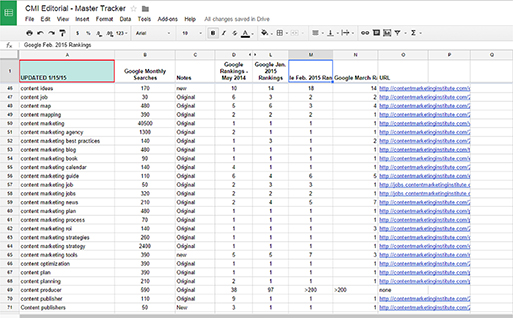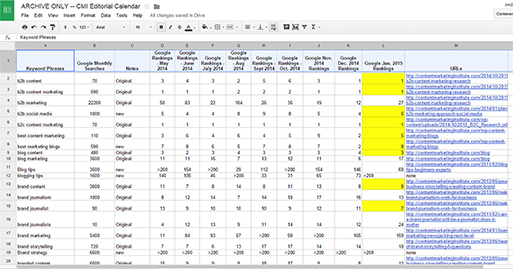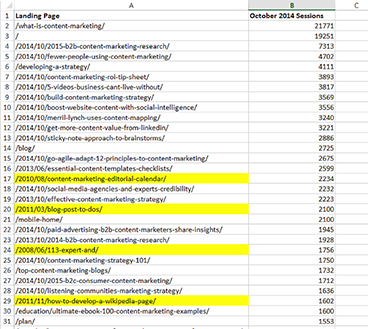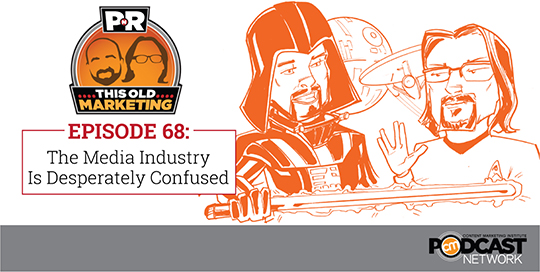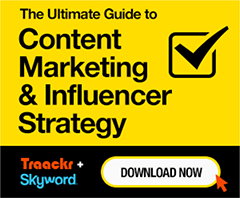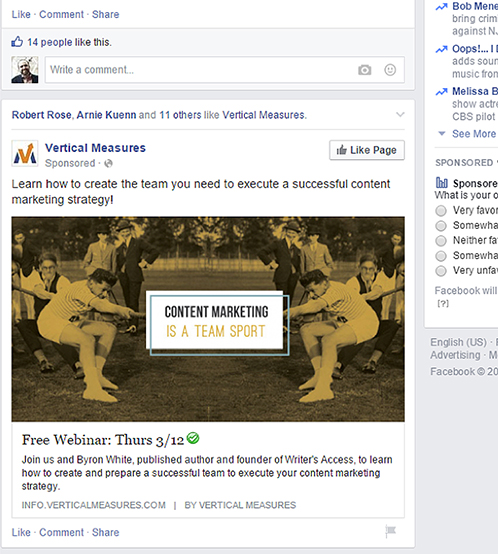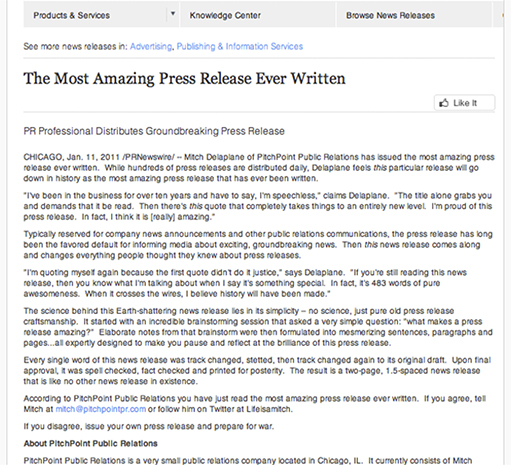Chapter 15
Building for Findability
The true delight is in the finding out rather than in the knowing.
Matt Cutts, Google’s leading search evangelist, recently declared: “I firmly support the idea that people should have a diversified way of reaching their audience. So if you rely only on Google that might not be as strong of an approach compared to having a wide variety of different avenues by which you can reach people and drive them to your website or whatever your objective is.”
According to the 2015 Content Marketing Benchmark research from Content Marketing Institute and MarketingProfs, more marketers are focusing on content promotion than ever before. Why? Companies of all sizes are spending vast amounts of money on content creation, only to find out that no one is engaging in that content. Developing ongoing content without a clear strategy for content findability is no plan at all.
SEARCH ENGINE OPTIMIZATION
Getting your content found through search engines is the king of content findability. According to web presence management company Conductor, approximately half of all web traffic comes from organic search (nonpaid results).
For the Content Inc. model to be successful, you need to focus on search engine optimization (SEO) at all times. For a long time, the members of CMI’s staff believed that if they understood the basics of SEO and created valuable, shareable content, the content would be found in the organic search rankings. Although respectable traffic was coming to our site from search engines, getting a lot more serious about SEO in the last few years more than doubled search results—and doubled our business in the process. Better yet, the majority of new subscribers come in through search engines rather than any other source. Needless to say, SEO is critical for our survival.
Your “Hit List” of Keywords
Every month CMI reviews a “rolling list” of our top 50 keyword phrases (like “content marketing” or “how to curate content”). For each phrase, we monitor our placement in Google, check how we are doing against competitors, and determine how we are trending from the previous month (are we doing better or worse?). (See Figure 15.1.)
Figure 15.1 CMI analyzes a rolling set of 50 keywords per month to track search engine optimization performance.
We also look at the results on a historical basis to track how the team is doing on our most important keywords (Figure 15.2).
Figure 15.2 Every keyword phrase’s performance is tracked monthly in Google and Bing, along with the link to the piece of content that is ranked.
Our goal is to drive subscriptions from every page of content. The CMI staff treats every page like a landing page and monitors top pages for ways to increase traffic to a specific page, as well as increase the conversion of readers to subscribers (Figure 15.3).
Figure 15.3 Every content page is treated like a landing page, and each one is measured on how many subscribers come in through each page.
How do we build a strategy for this concept? Below, CMI’s SEO specialist Mike Murray explains how to integrate search in the Content Inc. model.
If half of your traffic comes from organic search, where does the other half come from? Here are a number of tactics you should consider as part of your model.
GUEST APPEARANCES IN OPC
As noted earlier in the book, OPC is short for “other people’s content.” The more our thinking gets spread around in OPC, the better chances we will have to attract new people to our site and build subscribers. As you develop better relationships with influencers (see Chapter 16), one of your goals is to find opportunity to help those influencers with their content. That could mean developing a guest blog post for them or guest-starring in a webinar for their audience.
Since 2007, I’ve written original or repurposed articles for over 200 different websites. At the same time, I’ve participated in over 30 outside webinars a year. These two activities have been critical to our success. How do I know? In February 2015, users came to the CMI site from over 2,500 different places. Much of that diversity is because we share content on other people’s sites.
CREATE MORE LISTS WITH YOUR CONTENT
As much as I’m not a fan of this, lists get found and shared. As a result, more people blog and link to that content, making it easier to be found in search engines. CMI’s best-performing content is almost always a numbered list.
Even more impactful is compiling an industry list of influencers. Forbes magazine is perhaps the king of this—the magazine develops multiple “best of” reports each month (Figure 15.4).
Figure 15.4 Forbes executes a number of “best of” programs, including this one.
CONSIDER STUMBLEUPON
According to analytics blog KISSmetrics, many businesses overlook the value of Stumbleupon as part of their content promotion activities. Readers use Stumbleupon to find or “stumble” onto relevant articles and sites based on their current interests.
Statcounter found that of the top seven most-trafficked sites, Stumbleupon is one of the leaders in driving traffic to those sites. Adding Stumbleupon to your site toolbar would be a solid first step.
GET INVOLVED WITH REDDIT
In February 2015, community site Reddit had over 150 million unique visitors. On Reddit, consumers of every interest share stories, vote, and comment. Depending on your niche area, there may be a few subgroups, called subreddits, where conversations are happening. By being active in these communities, you may receive opportunities to share your expertise—and your articles.
CREATE UNIQUE RESEARCH
It’s not even close. More sites share our original research than anything else we do. If this could be an opportunity for you, be sure you plan your research as an ongoing series, like quarterly or annually. That means every time the research is released, you have something new and amazing to talk about.
ANSWER QUESTIONS AT QUORA
Quora is a question-and-answer platform. Most likely, possible subscribers are asking questions that you may be able to answer, again showing your expertise and driving people to your website.
CONTENT SYNDICATION
Syndicating your content means you actively place your articles on other people’s sites. In the past, many have thought that search engines like Google penalize your site for duplicate content. Google says this isn’t true: “Let’s put this to bed once and for all, folks: There’s no such thing as a ‘duplicate content penalty.’”
Michael Brenner, head of strategy for NewsCred, believes that content syndication is an untapped opportunity. As he shares:
At SAP, I built an award-winning content marketing hub called SAP Business Innovation and started it with little budget. How do you build a content hub on a small budget? You need an army of volunteer content contributors.
I did this by syndicating content from other experts (mostly employees, to start) with their permission. When I started showing business results and my budgets increased, I added licensed content as well as additional paid original content.
Licensing your content to other sites (syndication) may make sense to give you the added distribution you need. And even though I believe original content creation is the number one option for Content Inc. models to grow, syndicating other people’s content may be something to consider until your content factory is in full gear.
Organizations like Newscred and PR Newswire should be considered if this interests you.
LEVERAGE HARO
Help a Reporter Out, or HARO, is a site for journalists and reporters looking for expert content sources. CMI has used HARO for the past few years and received placement in the New York Times because of it.
ADD IMAGES TO YOUR TEXT CONTENT
Skyword research has found that business-oriented web pages with images have performed 91 percent better than those pages without images. When in doubt, always add an image to your textual content (Figure 15.5).
Figure 15.5 For my podcast This Old Marketing with Robert Rose, CMI develops a custom image that is leveraged as part of our social media promotion.
Sites like Huffington Post and BuzzFeed practice this religiously. Adding images does not have to be an arduous process. Consider the following:
![]() As you develop your content calendar, hire a graphic designer to develop customized posts.
As you develop your content calendar, hire a graphic designer to develop customized posts.
![]() Subscribe to an online image service like BigStock or Shutterstock. While this is fine, we still recommend having a designer go into the image and customize it enough to make it your own.
Subscribe to an online image service like BigStock or Shutterstock. While this is fine, we still recommend having a designer go into the image and customize it enough to make it your own.
![]() Do it yourself, using a program such as Canva.
Do it yourself, using a program such as Canva.
MAKE SURE MOST OF YOUR CONTENT IS UNGATED
In the summer of 2014, I conducted a workshop for some leading trade associations. The majority of them were struggling with getting their content found on the web. Why? Because 90 percent of their content was only accessible to members, who had to log in to access the content. This means that 90 percent of their content goes unnoticed by search engines, and users who like the content can’t share it on social media.
According to noted author and speaker David Meerman Scott’s personal statistics, a white paper or e-book of his will be downloaded at least 20 times more and up to 50 times more without a gate in front of it. You get better results without a lead form in front of downloadable content.
Yes, you want certain content assets with a form in front of them to grow your subscriber lists, but the vast majority of your content needs to be easily accessible to your audience, enhancing both search and social media sharing opportunities.
BRANDSCAPING
Brandscaping, according to author Andrew Davis, is defined as “a collection of brands working together to produce great content” (see Figure 15.6). Think of an example where you have great content, but you need additional marketing exposure. Or possibly someone in your industry has some amazing research that you really want to share with your audience. In these cases, perhaps a partnership can be created.
Figure 15.6 Two different companies, Traackr and Skyword, partnered together (brandscaping) on an educational e-book.
Test Your Titles like Upworthy
Upworthy, one of the fastest-growing sites on the web, focuses on sharing and curating content that (it believes) uplifts the rest of humanity. In December 2013, over 87 million people visited Upworthy.
What accounts for the extraordinary number of visits? According to Upworthy, “It was because millions of members of the Upworthy community watched the videos we curated and found them important, compelling, and worth sharing with their friends.”
How does Upworthy get people to open its e-mails to watch the videos and then share them with friends? The Upworthy staff is meticulous about its headlines. For each article, Upworthy writes a minimum of 25 different headlines. Then the company does various A/B tests with its subscription lists to see which headline led to the most e-mail opens and the most shares. Once Upworthy finds the best performer, the company distributes that winning headline to the entire e-mail database.
PAID CONTENT DISTRIBUTION OPTIONS
Before you gain organic search traction and build a massive audience of subscribers, your content may need a boost to gain readership. It is completely acceptable to engage in paid content distribution techniques to acquire new subscribers. Here are a couple to consider:
![]() Pay per click. Until you can be found in your target keywords on search engines, it may make sense to pay for promotion. Pay per click (PPC) is the idea that you promote your content on search engines and are charged every time someone clicks on your link. PPC charges can range from 5 cents for less popular keyword phrases up to multiple dollars per click for popular searches (like “mesothelioma”).
Pay per click. Until you can be found in your target keywords on search engines, it may make sense to pay for promotion. Pay per click (PPC) is the idea that you promote your content on search engines and are charged every time someone clicks on your link. PPC charges can range from 5 cents for less popular keyword phrases up to multiple dollars per click for popular searches (like “mesothelioma”).
![]() Content discovery/recommendation tools. Services like Outbrain, Taboola, and nRelate form partnerships with media and blogging sites and will promote your content, for a fee, on the sites of your choosing. The investment works exactly the same as for PPC (you are charged every time someone clicks on your story). The biggest difference with content recommendation tools is that the content has to be in the form of an interesting story (or the services won’t show it). Figure 15.7 shows what a content recommendation section looks like on CNN.com.
Content discovery/recommendation tools. Services like Outbrain, Taboola, and nRelate form partnerships with media and blogging sites and will promote your content, for a fee, on the sites of your choosing. The investment works exactly the same as for PPC (you are charged every time someone clicks on your story). The biggest difference with content recommendation tools is that the content has to be in the form of an interesting story (or the services won’t show it). Figure 15.7 shows what a content recommendation section looks like on CNN.com.
Figure 15.7 Many publishers, including CNN, use content discovery engines at the bottom of their articles to promote relevant (and sponsored) content.
SOCIAL MEDIA ADVERTISING
Almost every social website, including Facebook, LinkedIn, Twitter, and Instagram, accepts advertising. Each of these services lets you target very specific audiences with your content. Figure 15.8 presents an example from Facebook promoting a webinar (promoting valuable content is the best way to leverage social advertising).
Figure 15.8 Promoting your content in social media outlets like Facebook can be a great way to target a very specific audience with content.
NEWS RELEASE SERVICES
Services such as PR Newswire and PRWeb will take your press release and distribute it to the media sites of your choosing for additional promotion. Remember, there is no set format. You can be as creative as you can to get attention among the thousands of other releases sent out that day. PR professional Mitch Delaplane had a bit of fun with his press release in 2011 and ended up being promoted on sites, such as TechCrunch, as the “best press release ever” (Figure 15.9).
Figure 15.9 Mitch Delaplane’s “best press release ever” was picked up by multiple media outlets.
For more information on promotion options for your content, check out Chad Pollitt’s guide to content promotion (http://cmi.media/CI-promotion) and Robert Rose’s full report on content discovery tools (http://cmi.media/CI-native).
CONTENT INC. INSIGHTS
![]() While there are many ways for your content to be found, the center of the findability universe is search.
While there are many ways for your content to be found, the center of the findability universe is search.
![]() While setting your content to be found in search engines is not rocket science, most companies don’t do the small things needed to be found by search engines. Be sure to create a process for this.
While setting your content to be found in search engines is not rocket science, most companies don’t do the small things needed to be found by search engines. Be sure to create a process for this.
![]() Advertising your content to build subscribers is a viable option. Look at all available channels to see how you can get your content in front of the right people.
Advertising your content to build subscribers is a viable option. Look at all available channels to see how you can get your content in front of the right people.
Resources
Eric Enge, “Link Building Is Not Illegal (or Inherently Bad) with Matt Cutts,” stonetemple.com, accessed April 28, 2015, https://www.stonetemple.com/link-building-is-not-illegal-or-bad/.
Nathan Safran, “310 Million Visits: Nearly Half of All Web Site Traffic Comes from Natural Search [Data],” conductor.com, accessed April 28, 2015, http://www.conductor.com/blog/2013/06/data-310-million-visits-nearly-half-of-all-web-site-traffic-comes-from-natural-search/.
Kristi Hines, “4 Ways to Increase Traffic with StumbleUpon,” KISSmetrics.com, accessed April 28, 2015, https://blog.kissmetrics.com/increase-traffic-with-stumbleupon/.
Google Support, “Duplicate Content,” Google.com, accessed April 28, 2015, https://support.google.com/webmasters/answer/66359?hl=en.
Michael Brenner, “Get the Biggest SEO Bang for Your Content Marketing Buck,” ContentMarketingInstitute.com, accessed April 28, 2015, http://contentmarketinginstitute.com/2015/03/brenner-seo-content-marketing/.
Upworthy Insider, “What Actually Makes Things Go Viral Will Blow Your Mind,” Upworthy.com, accessed April 28, 2015, http://blog.upworthy.com/post/69093440334/what-actually-makes-things-go-viral-will-blow-your.
Alexia Tsotsis, “The Most Amazing Press Release Ever Written,” techcrunch.com, accessed April 28, 2015, http://techcrunch.com/2011/01/12/news-about-news/.

